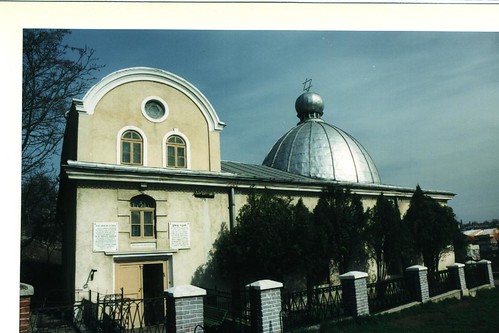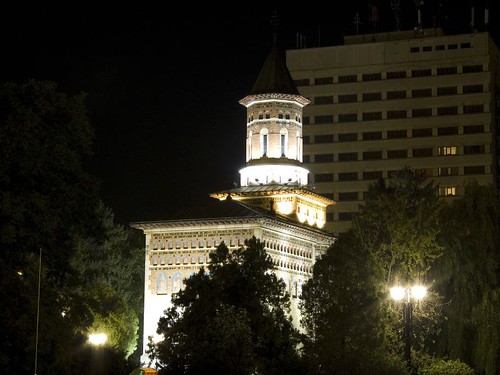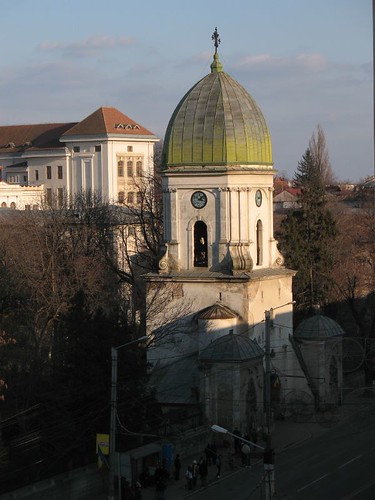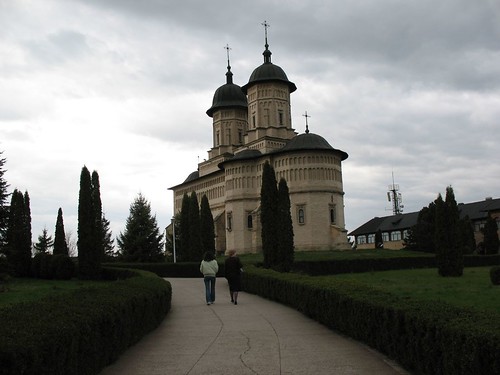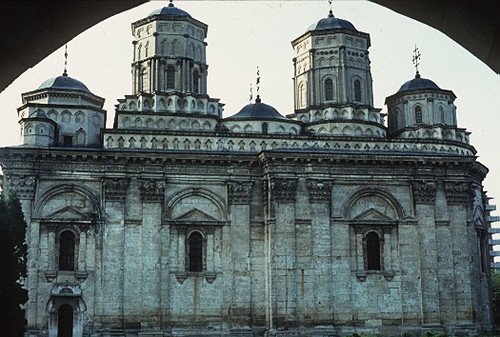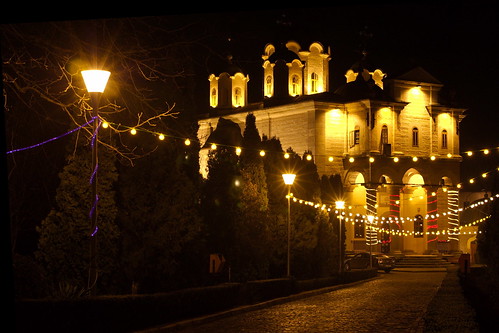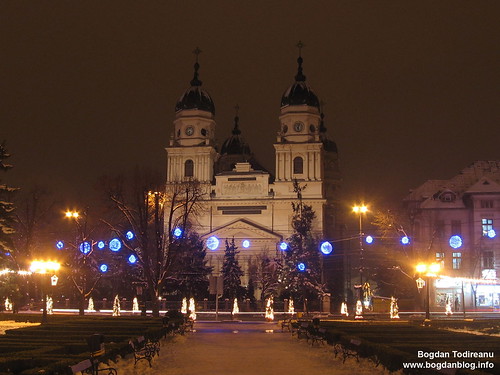Tuesday, May 20, 2008
Thursday, May 8, 2008
The monastery and the castle in Micaluseni
Situated close to Siret’s marsh, on the left side of the European road E583, the monastery owes its name to High Steward Miclaus who received these lands around 1410-1416.
The church was built between 1821-1823 by the great chancellor Dimitre Sturza (1756-1846) and his wife Elenco. A Classical monumental building, the church consists of four vaulted rooms: the porch, the pronave, the nave and the altar.
Miclauseni Castle, historical monument belonging to the Gothic art, was built between 1880-1904 by George A. Sturza and his wife Maria (born Ghica). The exterior decorations bring forward details from the Sturza’s blazon and also the emblem of George A. Sturza. The castle was the possessor of a remarkable library of about 60,000 volumes; among them many first editions or extremely rare volumes.
Hlincea Monastery
The today’s church, situated at about 3 km South-West of Cetatuia Monastery, was built by Vasile Lupu and finished by his son Stefanita Voda on of November 1660. The church built in the Moldavian architectural style is made of rock and brick. The painting belonging to Ioan Matei was accomplished in 1660. Between 1788-1792 and 1806-1812 (when Iasi was invaded by the Russian troops), the monastery served as military hospital.
Dobrovat Monastery
It was built between 1503-1504. Its painting was done in 1529, during the reign of Petru Rares, both in interior and in exterior. The nave’s painting is considered the most beautiful in Moldavia. Only two little fragments are still preserved from the exterior painting. In 1651, during Vasile Lupu’s reign, the monastery was donated to Mount Athos until 1863, at Cuza’s secularization. Till 1902 the monastery functioned as a prison, then it was completely abandoned. After being transformed in a girl orphanage and an agricultural school, between 1930-1948 it returned to the monastic life, but it was closed in 1948 and it remained so until 1990 when it was reopened.
Tuesday, April 29, 2008
Churches in Iasi - The Great Synagogue
It was built between 1659-1670, is the oldest of Jewish praying houses in Romania . If in exterior it is very simple, without any decorations, the interior is as sophisticated as possible, decorated and gifted with valuable objects: chandeliers, candlesticks.
Churches in Iasi - Armenian Church
A true historical monument, this church testifies the existence of an important Armenian community in these parts of Romania . Restored in 1803, this halidom lodges an array of rocks with inscriptions, one of them certifying the beginnings of the building in 1385 by Macar.
In 1451 the church was endowed with a Gospel written and illustrated in Caffa from Crimeea, 100 years before.
Churches in Iasi - Catholic cathedral
The building of the old cathedral was first built from wood in 1753, on the place of an older church. Between 1782-1789, the church was rebuilt from brick and it remained so until these days. By the time, it suffered some restoration works, especially after the 1802’s earthquake and the blaze in 1827.
In 1861, at the initiative of bishop Iosif Salandri, some new works of restoration and extension were made and the interior of the church was painted by Giuseppe Carta from Palermo . White marble altars and via cruces icons were also brought. Today, near the old cathedral, one can see a new church, a very modern building, circular and which has in its central part an oblong spire finished by a cross.
churches in iasi St. Nichlolas(Sfantul Nicolae Domnesc)
It was built at the initiative of sovereign Stefan cel Mare between of June 1491- of August 1492. It is considered the oldest religious edifice preserved in Iasi until now.
The today’s church is that of 1904. The restoration works were led by the French architect Lecomte du Nouy. He tried to keep both the style and the characteristics of the church built by Stefan cel Mare.
Churches in Iasi - Sf. Spiridon church
Today’s “Saint Spiridon” Church was built between 1805-1807 on the place of an older and smaller church which was seriously damaged by the earthquake on 26th October 1802 . according to the rotive in the church porch, written in Romanian with Cyrillic letters and dating from 1847, on this place were also built, in time, other three churches. These ones suffered either because of some natural phenomena, either because of foreign occupation. The steeple tower of the church dates from 1786. Its architecture was influenced by the decorative elements of the Russian Baroque. In the inferior part of the steeple tower there are two water pumps with the sovereign’s mark on their frontispiece.
Churches in Iasi - “Saint Sava” Church
The first information concerning it dates from 1583 when a little church was built with the help of sprince Petru Schiopu. In 1625, boyar Enache Caragea built the present “Saint Sava” church, in Oriental style. Between 1676-1678, during prince Antonie Russet, the wall surrendering the monastery was built. Destroyed by time, the church was restored in two important steps: in 1820, when it was completely rebuilt and in 1844, when it was renewed. However, the monastery preserved its original Byzantine character of the 17, unique in the Moldavian architecture.
Churches in Iasi - Barnovschi Church
churches in iasi Galata Monastery
Frumoasa Monastery
Churches in Iasi - “Three Hierarchs” Monastery
“Three Hierarchs” Monastery is the most beautiful foundation of sovereign of Vasile Lupu, prince of Moldavia , built between 1637-1639.
During 1882-1904 restoration works took place under the supervision of the French architect Lecomte de Nouy. The exterior decorations completely covering the building were gilded at the beginning, and combine Turkish, Arab, Georgian, Armenian and Persian elements with Romanian architectural motives in a wonderful rock lace. Over 30 registers of decorative motifs can be noticed.
Inside the monastery, members of Vasile Lupu’s family, Dimitrie Cantemir and Alexandru Ioan Cuza are buried.
churches in Iasi Cetatuia Monastery
Cetatuia Monastery was built by sovereign Gheorghe Duca between 1669-1672. At the beginning, the church was surrounded by high rock walls, with bulwarks and a guard road, entrance and corner towers.
What makes Cetatuia unique is that it has maintained the whole ensemble of monastic architecture. On the Southern part of the precinct stands the Gothic Room “Doamna Anastasia”. The royal palace is a fortified building from the 17 century. The steeple tower and the massiveness of the walls are proving the fact that the monastery was conceived also as a refuge place, being in case of need, a real fortress.
The monastery’s church is specific for the religious Moldavian architecture of the 17century.
The monastic ensemble which was restored in the inter-war period at Nicolae Iorga’s request also includes a museum with numerous religious objects.
Churches in iasi golia monastery
Old foundation from the 16 century of chancellor Ioan Golia, the church was restored at other dimensions by sovereign Vasile Lupu between 1650-1653 and finished by his son, Stefanita Voda.
The monastery is surrounded by a high wall, with spires at the corners raised in 1667 and a steeple tower restored in 1900.
The tower of Golia is 30 m height. The visitor who wants to have a panorama of the city has to climb 120 stairs. The tower is one of city’s symbols.
During 1943-1947 restoration works took place at Golia, the monastery’s church being reopened after that.
In 1955, in two rooms on the Eastern part of the precinct, “Creanga” Museum was inaugurated, with documentary materials regarding the life of the great writer which was curate of monastery’s church.
Churches in Iasi - Barboi Church
Churches in Iasi - The Metropolitan Cathedral
Bishop Veniamin Costache is the one who had the idea of building in
It was inaugurated on 23April 1887, at this event also taking part King Carol I and Bishop Iosif Naniescu.
http://farm3.static.flickr.com/2274/2126028138_f04a0e12f5.jpg?v=0
http://farm3.static.flickr.com/2199/2394170784_1999f4c532_o.jpg


